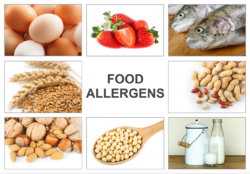 Have you ever been on an airplane and were told the in-flight service would no longer include free peanuts due to allergies?
Have you ever been on an airplane and were told the in-flight service would no longer include free peanuts due to allergies?
Rather than curse the darkness, I strive for the light. So I took a class on allergens to better understand the subject. I came to discover that cross-contact is as dangerous to allergy sufferers as cross-contamination from bacteria.
Most of us are aware of shellfish allergies, but in recent years other food allergies have risen to a level of seriousness where consideration is a must when it comes to menu planning and standard operating procedures (SOPs).
According to the U.S. Food and Drug Administration (FDA), more than 160 foods can cause allergic reactions to people with food allergies. Of these, the FDA has identified eight foods (commonly classified as the “Big 8”) known to account for 90 percent of food allergic reactions. These foods include milk, eggs, fish, shellfish, tree nuts, peanuts (which are actually legumes, not nuts) wheat (protein or more specifically, gluten) and soybeans.
Everyone knows peanuts can pose serious problems to those who are allergic to them, but I was surprised to learn just how potent they can be. When that little pack of peanuts is opened, the dust can become airborne and incapacitate the person with the allergy almost immediately.
While I have not personally experienced this on a plane, I have experienced an allergic reaction during a campout when a young scout with a severe peanut allergy was exposed to peanut butter residue on a sandwich.
The young scout’s ham sandwich was made on the same workspace that was used to make peanut butter sandwiches, resulting in cross-contact in the prep area. While this was unintentional, it could have easily been avoided.
The simplest way to avoid cross-contamination would have been to make the ham sandwich first, before the peanut butter could have been applied to the other sandwiches. Using a separate surface (like a paper plate) and a separate utensil to prepare the ham sandwich is another way the situation could have been avoided.
As a customer advisor and volunteer operator of a Boy Scouts of America camp dining facility, I am pleased to make accommodation plans for people who have food allergies. The best way to prepare for these requests is through the implementation of an allergen awareness process.
This process can easily be added to an operation’s SOP and if followed, will ensure that staff members are making every effort to provide a safe and enjoyable dining experience for everyone.
One of the steps in an allergen awareness program requires the pre-prep cleaning method. This includes applying an all-purpose general cleaner with a clean, single-use paper towel, then rinsing and sanitizing the work surface and drying with another single-use paper towel.
Since kitchen wipers may contain trace amounts of allergens even when they have been cleaned, making sure to wash and dry items with a clean, single-use paper towel will help you avoid a serious allergic reaction and uphold religious or dietary preferences (vegetarian or vegan). The prevention of cross-contact through food residue is a must before you prepare these types of special orders … or anything that involves rutabagas. While my least favorite, a rutabaga diet would likely be the best weight-loss plan ever for me. (OK, I’m having a bit of fun here, but you get the point.) If you want a safe dining experience for all of your guests, starting with a clean work surface is a critical first step.
Health and safety issues aside, there’s another benefit to making these special dietary accommodations. By appealing to a wider segment of guests, you can actually increase your bottom line.
Let’s take a look at a customer mix factor I use when discussing menu offerings with operators. For example, let’s say we have six guests seated at the same table for lunch and dinner. Some might prefer to order traditional meat and potatoes, another a seafood dish. Others might request a salad or vegetarian meal. Two of the guests at the table may have allergies, and of course, there’s that one person who refuses to eat anything but rutabagas.
A great way to think ahead and serve these guests is through the use of icons to call out gluten-free, vegan or dairy-free selections on your menu (in print and online). These are universally accepted icons and quite often searched by one or more guests at the table.
The next time you review your menu and food preparation plans, consider the impact you can have on your business and your guest’s satisfaction with an effective allergen program.
If you need more information on how to create the right environment for preventing these issues in your kitchen, contact your local representative. They can help you design a prep space with the addition of a 48-inch 8000 series prep table, complete with ingredient separation and interchangeable cutting boards to virtually eliminate the very real risk of cross-contact or cross-contamination from your food service operation.
Enjoy the food!
Michael Williams